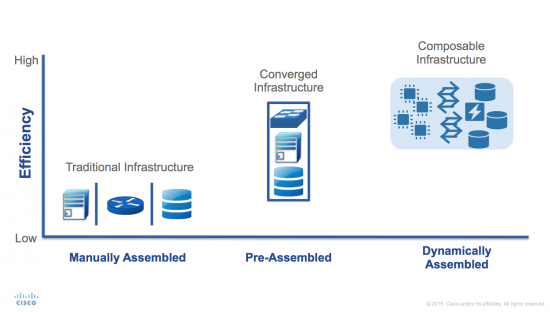































 We recently sat down with IDC analyst, Jed Scaramella, to talk about an interesting and accelerating trend in data center technology:composable infrastructure. With UCS M-Series servers, Cisco has taken an important step forward in this space. To help frame things up, we asked Jed for his take on the market drivers and customer needs fueling innovation. We've broken the conversation with Jed into a series and hope to shed some light on how this will re-shape computing architecture and the opportunities for IT.
We recently sat down with IDC analyst, Jed Scaramella, to talk about an interesting and accelerating trend in data center technology:composable infrastructure. With UCS M-Series servers, Cisco has taken an important step forward in this space. To help frame things up, we asked Jed for his take on the market drivers and customer needs fueling innovation. We've broken the conversation with Jed into a series and hope to shed some light on how this will re-shape computing architecture and the opportunities for IT.
A new generation of applications is driving demand for comprehensive infrastructure automation in the data center. In the first blog in this series, Jed described the industry shift to what IDC calls the3rd Platform. The 3rd Platform is emerging with the digital transformation of business, transportation, entertainment, healthcare, etc. This significant technology shift requires systems that are far more adaptive. The infrastructure resources must be assembled on demand. They need to be software defined, pooled and composed to meet the requirements of applications and workloads. Evidence of this need is the growing desire for "infrastructure as code" within the DevOps community.

Integrated and converged infrastructure (think VBlock and FlexPod) has solved a lot of problems by pre-engineering the complete computing platform for customers. This architecture has significantly helped IT teams deploy and scale applications faster, to drive the revenue side of the business, while reducing risk and cost of operations. With our strategic storage partners, we've pioneered this space under the banner of Cisco UCS Integrated Infrastructure, and systems based on Cisco UCS and Nexus lead the market today.
Looking at the next horizon, composable infrastructure offers more granular automation and utilization of the various resources that applications need. This is accomplished by "disaggregating" the components of the traditional server and recombining them in the specific ratios that applications need, when and where they need them. Cisco UCS M-Series Modular Servers is the first example of Cisco Composable Infrastructure?, designed to dynamically assemble the building blocks within the server and across the datacenter.
In some ways it may seem counter-intuitive, we took such great pains to converge everything, and now we're breaking it apart again. One thing is certain: nobody cares about a disaggregated server, it's just a pile of parts. What's important is how we can re-assemble the parts and do that in a way that can be driven dynamically by the needs of the workloads. Moreover, the full-credit answer is adding this capability while retaining the simplicity that converged infrastructure delivered. It's a tall order, but we've developed a lot of experience in abstracting HW and connecting the parts with UCS over the past six years, and we're driving straight into composable infrastructure with that momentum behind us.
In this first video, Jed and Jim McHugh discuss the applications driving the demand for composable infrastructure and potential benefits. Jed has also written a paper entitled, "Orchestrating Efficiency with Composable Infrastructure."

This technology will play an important role in the future of IT by providing the flexibility needed for the dynamic applications of the 3rdPlatform and digital transformation of the enterprise. I hope you find this series informative. Watch this space.... we're only just getting started.
-Todd
 Hot Tags :
Data Center
UCS
devops
servers
containers
orchestration
UCS m-series
Composable Infrastructure
Hot Tags :
Data Center
UCS
devops
servers
containers
orchestration
UCS m-series
Composable Infrastructure